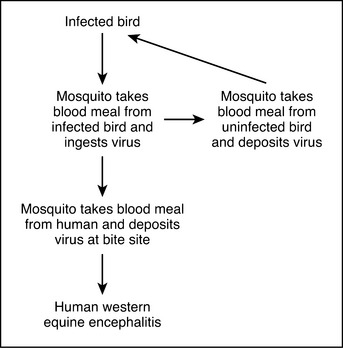WESTERN EQUINE ENCEPHALITIS
Western equine encephalitis is a viral disease of horses and humans. It is seen mostly west of the Mississippi River in the United States and in corresponding provinces in Canada.
TRANSMISSION
WEEV is found mainly in or near farmland or irrigated fields and is transmitted through the bite of an infected mosquito (Figure 52). Horses and humans are infected when a mosquito takes a meal from an infected bird and subsequently bites a horse or human. The mosquito deposits the virus in the blood when it feeds. Horses and humans do not develop a level of virus in the blood significant enough to make them a source of infection to other animals via a mosquito bite; they are, therefore, considered dead-end hosts.
WESTERN EQUINE ENCEPHALITIS IN HORSES
WEE is a central nervous system disease in horses, but the disease is not as severe as the one caused by EEEV. The clinical signs of WEE, seen from 5 days to 3 weeks after infection, include fever, depression, anorexia, sensitivity to light, staggering, circling, disorientation, paralysis, and death. Even though WEEV is considered less pathogenic than EEEV, the mortality rate for animals showing clinical signs can reach 20% to 50%. Animals that are not severely affected by WEE recover in a couple of weeks, but permanent brain damage, especially abnormal reflexes, may remain.
Stay updated, free articles. Join our Telegram channel

Full access? Get Clinical Tree



